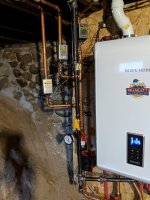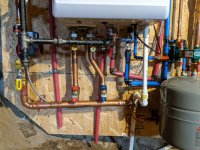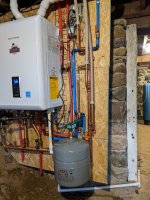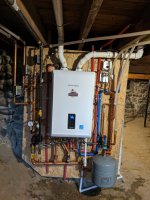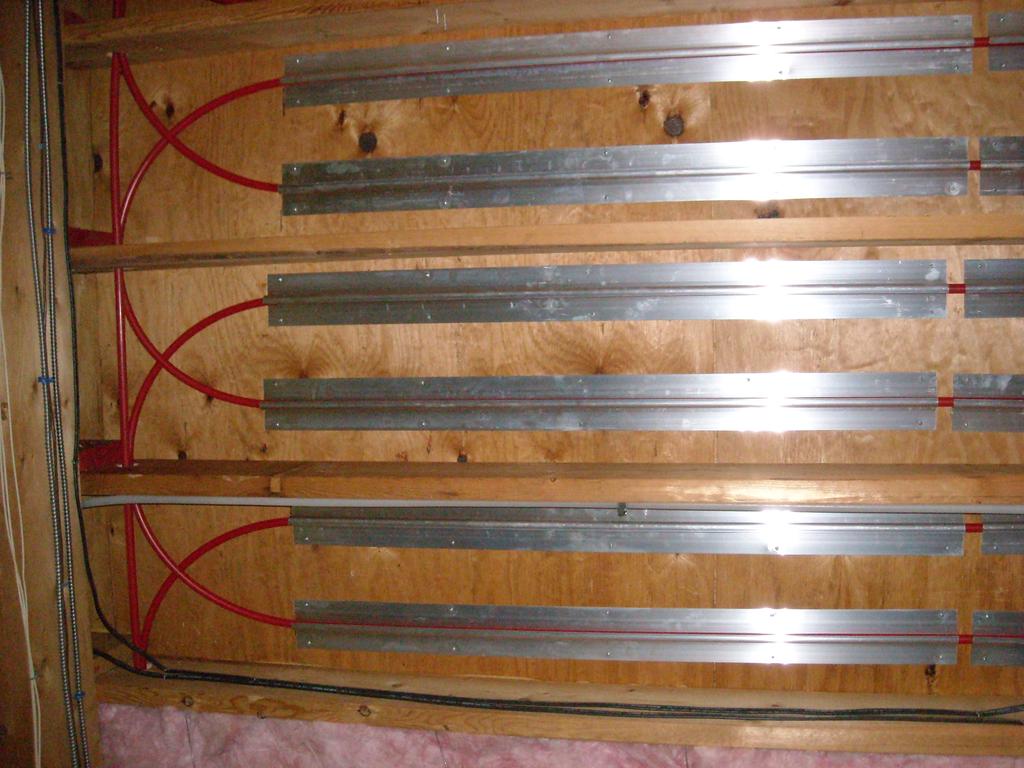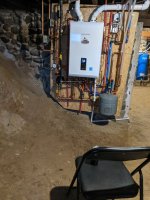jeff711981
New Member
I apologize in advance for the length of this post, my first post here, but I moved into a new house about 3 months ago and had to replace the boiler immediately. The old Munchkin one had gas leaks in the valve train and apparently Munchkin was sued out of business so people won't work on them anymore.
Long story short, I ended up having the NCB 240e combi-boiler installed. My home is about 2250 sq/ft, parts of it date back to 1880 and the most recent addition is 40 years old, so insulation is not perfect - there are lots of drafts. The heating design is all fin-tube baseboard. There are three zones in the house. Family room (addition), first floor, and 2nd floor.
The plumbing for the fin-tube baseboard elements looks rather poor. There are some connections that look heavily corroded and last night I just had one spring a leak. I've got the company who installed my boiler coming out tomorrow to help bypass the section with the leak (it's a really janky looking series of fin-tubes under the kitchen floor... kind of a makeshift radiant floor heating system). Eventually I need to replace all this, but for now, I'm just having them bypass the leak so I can stop rotating buckets every 3 hours in order to keep the heat on.
But I have some questions about the system as I am new to hydronic heating systems.
First, I'm observing about a 10 degree F delta between supply and return. For example, right now I took a look at the unit and the supply temp is 127, and the return is 116. I have roughly 25-30 feet of fin-tube elements in a 20x20 room with a vaulted ceiling. With some research online, I estimate the heat load of the room to be about 12,000 BTU. Assuming my fin-tube elements are working as good as modern new ones, and they're roughly 300 BTU/ft at 120-130ish water temp, this means I'm roughly 4000 BTUs shy of what's required for a room this size. So by either adding more fin-tube elements, or swapping the existing for higher efficiency ones, I should see a larger drop in return temp compared to supply temp, right? This would explain why the system can't maintain the 70 degree temp I have set (it dropped from 70 to 66 when I set the space heating temp to 130 instead of 150).
Second, I have no outdoor temp sensor (I'm in the process of requesting that the installer provide it, since he even described its function to me when he sold me the boiler), but given that I need the supply water to be somewhere in between 130 and 150 to maintain my desired temperature, if I'm only getting a 10 degree temperature drop and my return water temp is above 130, the boiler is likely not condensing much, if at all, and so I'm going to be in the mid 80s in regard to efficiency, right?
Third, I've had the boiler in for 6 weeks and I've gone through 400 gallons of propane. For the first 3 weeks, the zones were mixed up and I had to play games with the thermostats to keep the different zones reasonable, but occasionally overnight things got out of whack and I woke up to temps in the high 70s on several occasions. So I wasted a lot of fuel due to that. Regardless... I'm really unhappy with the fuel consumption as it doesn't appear to have slowed down at all now that the zones are corrected, and I believe that's because the installer didn't install the outdoor temp sensor, and had set the supply temp to 180 during the initial install, and 170 after having come back to correct the zones. Regardless, this rate of consumption is over double what I expected... I expected to have to fill my 850 gallon propane take maybe twice per year. At this rate I'm going to have to fill it 2-3 times before this Michigan winter is over. Am I correct that this is excessive?
And finally (I think), going back to my first point/question, I have a (manual) variable speed circulator pump... I'm not an HVAC expert, but it seems to me that if I slow the pump down, the water is "out and about" longer and that should help achieve lower return temps - is my logic sound?
Long story short, I ended up having the NCB 240e combi-boiler installed. My home is about 2250 sq/ft, parts of it date back to 1880 and the most recent addition is 40 years old, so insulation is not perfect - there are lots of drafts. The heating design is all fin-tube baseboard. There are three zones in the house. Family room (addition), first floor, and 2nd floor.
The plumbing for the fin-tube baseboard elements looks rather poor. There are some connections that look heavily corroded and last night I just had one spring a leak. I've got the company who installed my boiler coming out tomorrow to help bypass the section with the leak (it's a really janky looking series of fin-tubes under the kitchen floor... kind of a makeshift radiant floor heating system). Eventually I need to replace all this, but for now, I'm just having them bypass the leak so I can stop rotating buckets every 3 hours in order to keep the heat on.
But I have some questions about the system as I am new to hydronic heating systems.
First, I'm observing about a 10 degree F delta between supply and return. For example, right now I took a look at the unit and the supply temp is 127, and the return is 116. I have roughly 25-30 feet of fin-tube elements in a 20x20 room with a vaulted ceiling. With some research online, I estimate the heat load of the room to be about 12,000 BTU. Assuming my fin-tube elements are working as good as modern new ones, and they're roughly 300 BTU/ft at 120-130ish water temp, this means I'm roughly 4000 BTUs shy of what's required for a room this size. So by either adding more fin-tube elements, or swapping the existing for higher efficiency ones, I should see a larger drop in return temp compared to supply temp, right? This would explain why the system can't maintain the 70 degree temp I have set (it dropped from 70 to 66 when I set the space heating temp to 130 instead of 150).
Second, I have no outdoor temp sensor (I'm in the process of requesting that the installer provide it, since he even described its function to me when he sold me the boiler), but given that I need the supply water to be somewhere in between 130 and 150 to maintain my desired temperature, if I'm only getting a 10 degree temperature drop and my return water temp is above 130, the boiler is likely not condensing much, if at all, and so I'm going to be in the mid 80s in regard to efficiency, right?
Third, I've had the boiler in for 6 weeks and I've gone through 400 gallons of propane. For the first 3 weeks, the zones were mixed up and I had to play games with the thermostats to keep the different zones reasonable, but occasionally overnight things got out of whack and I woke up to temps in the high 70s on several occasions. So I wasted a lot of fuel due to that. Regardless... I'm really unhappy with the fuel consumption as it doesn't appear to have slowed down at all now that the zones are corrected, and I believe that's because the installer didn't install the outdoor temp sensor, and had set the supply temp to 180 during the initial install, and 170 after having come back to correct the zones. Regardless, this rate of consumption is over double what I expected... I expected to have to fill my 850 gallon propane take maybe twice per year. At this rate I'm going to have to fill it 2-3 times before this Michigan winter is over. Am I correct that this is excessive?
And finally (I think), going back to my first point/question, I have a (manual) variable speed circulator pump... I'm not an HVAC expert, but it seems to me that if I slow the pump down, the water is "out and about" longer and that should help achieve lower return temps - is my logic sound?

